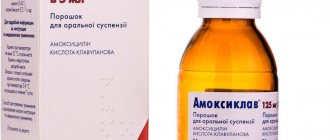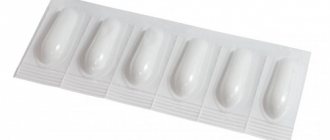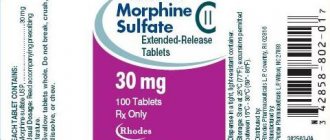Amoxiclav® is an antimicrobial drug with a wide spectrum of bactericidal activity, consisting of a semi-synthetic derivative of ampicillin (amoxicillin®) and an inhibitor of bacterial beta-lactamases (clavulanic acid). Clavulanic acid is able to prevent the enzymatic inactivation of penicillin by binding to bacterial beta-lactamases and forming inactive complexes with them. This enhancement mechanism helps to expand the spectrum of action due to its effectiveness against b-lactamase-producing strains resistant to amoxicillin.
It has good bioavailability and absorption, independent of food intake. Quickly penetrates into liquid media and body tissues. Maximum concentrations are achieved within an hour after consumption.
Mechanism of action of Amoxiclav
Amoxiclav contains ampicillin and clavulonic acid, which ensures the stability of ampicillin in the stomach and intestines, inhibiting the activity of enzymes (beta-lactamases) that destroy penicillin antibiotics.
Ampicillin is a semi-synthetic penicillin; it affects the strength of the bacterial cell wall, preventing its synthesis. As a result, the cell wall becomes thinner and the bacterium dies. Amoxiclav is a broad-spectrum antibiotic, among sensitive microorganisms: staphylococci, streptococci, enterobacteria, Haemophilus influenzae, Klebsiella, enterococci, gonococci and meningococci, salmonella and shigella, chlamydia and treponema. The antibiotic is well absorbed from the intestine, penetrating almost all tissues of the body, except brain tissue in the absence of inflammation of the meninges.
Penetrates through the placenta and into breast milk. Excreted in urine and partially in feces.
Analogs
Analogues of Amoxiclav include:
Find out your potency level
Take a free online test, which is used in international practice to determine the level of potency
Choose only one answer for each question. At the end of the test you will receive a conclusion.
5 simple questions
93% test accuracy
10 thousand tests
- Augmentin;
- Ecoclave;
- Panclave;
- Flemoclav;
- Arlet.
Contraindications to the use of Amoxiclav tablets and suspensions and side effects
According to the instructions for Amoxiclav, contraindications include hypersensitivity to the components of the drug, allergies to penicillins and cephalosporins, liver disease, jaundice, lymphocytic leukemia and mononucleosis.
With caution, the use of Amoxiclav is allowed for pseudomembranous colitis, liver failure, diseases of the gastrointestinal tract, pregnancy and lactation, and impaired renal function. Not recommended for use with anticoagulants.
Amoxiclav, like any antibiotic, has quite a lot of side effects, including: blackening of the tongue and darkening of tooth enamel, hemorrhagic colitis, loss of appetite, stomach pain, vomiting and nausea, constipation and diarrhea, gastritis, stomatitis, inflammation of the tongue, dysfunction liver, enterocolitis, liver failure. As well as hepatitis and jaundice, epidermal necrolysis, itching, rash, anaphylactic shock, angioedema, anemia, thrombocytopenia, leukopenia, agranulocytosis. In addition, there is an increase in bleeding time, convulsions, headache, dizziness, anxiety, hyperactivity, and agitation.
special instructions
The use of Amoxiclav 500+125 tablets should only be carried out as prescribed by a doctor. It is also advisable to read the instructions for the drug. Be sure to take into account special instructions regarding the use of this medicine:
- Before starting treatment, you must make sure that you have not had any allergic reactions in the past to taking antibiotics from the penicillin group and its analogues. If necessary, it is advisable to conduct an allergy test.
- The drug should be used only in case of development of a bacterial infection caused by bacteria sensitive to amoxicillin. Amoxiclav is ineffective against viruses. Before starting antibiotic therapy, it is optimal to conduct a bacteriological study to isolate a culture of the causative agent of the pathological process and determine its sensitivity to Amoxiclav.
- If there is no effect from starting to use Amoxiclav tablets within 48-72 hours, it is replaced with another antibiotic or the therapeutic tactics are changed.
- Amoxiclav is used very carefully in patients with concomitant liver or kidney dysfunction, and their functional activity is simultaneously monitored.
- While taking the drug (especially with a course of treatment exceeding 5 days), periodic clinical blood tests are necessary to monitor the number of its formed elements (red blood cells, leukocytes and platelets).
- There is no data on the damaging effect of Amoxiclav on the developing fetus. However, its use in the first trimester of pregnancy is undesirable. In late pregnancy and during breastfeeding, the drug is permitted for use, but should only be taken under the supervision of a physician.
- Amoxiclav tablets are not used for small children, as they contain a high concentration of active ingredients, intended for ages from 6 years.
- Combined use with drugs from other drug groups should be very careful. You cannot use drugs that reduce blood clotting or have a toxic effect on the liver or kidneys in parallel.
- Amoxiclav tablets do not have a negative effect on a person’s reaction speed and concentration.
All these special instructions regarding the use of Amoxiclav must be taken into account by the attending physician before prescribing it.
Interaction of Amoxiclav with other drugs
Aminoglycosides, antacids, laxatives and glucosamine slow down the absorption of the drug in the intestine. Allopurinol, diuretics and non-steroidal anti-inflammatory drugs increase its concentration. When used with metatrexate, it increases the toxicity of the latter. With Rifampicin, they mutually weaken each other’s effects, and the activity of ampicillin also decreases when used together with macrolide and tetracycline antibiotics.
The drug reduces the effectiveness of oral contraceptives.
Indications
The scope of application of amoxicillin and clavulanic acid includes the treatment of various infectious diseases caused by bacteria. But most often this combination is prescribed for the treatment of acute respiratory diseases. Amoxiclav reduces the severity of symptoms of the disease and shortens its duration.
For what infections is the drug prescribed:
- diseases of the upper and lower respiratory tract, lungs;
- urological, andrological and gynecological diseases;
- skin diseases caused by bacterial infection;
- connective and bone tissue infections;
- infectious cholecystitis and cholangitis.
Bacterial diseases of the respiratory organs for which the drug may be prescribed:
- pharyngitis,
- otitis,
- tonsillitis,
- laryngitis,
- rhinitis,
- sinusitis,
- sinusitis,
- pneumonia,
- pleurisy,
- bronchitis,
- tracheitis.
Bacterial infections of the urinary and genital organs for which the drug can be used:
- pyelonephritis,
- urethritis,
- prostatitis,
- adnexitis,
- endometritis,
- salpingitis.
It is also recommended to prescribe the drug for the prevention and treatment of infections associated with teeth and gums. The drug is also prescribed for the treatment of wounds, bites, and phlegmons.
How to use Amoxiclav
The dosage, frequency and timing of taking the drug are determined by the doctor, depending on the condition and complexion of the patient and the type of disease. Usually the drug is taken immediately before meals, for five to fourteen days. Adults take 250/125 mg of the drug three times a day, children weighing up to 40 kg take 40 mg per kg of body weight, children weighing more than 40 kg take the same dosages as adults. It is preferable to give Amoxiclav in suspension to young children. The instructions for Amoxiclav, located in the packaging of each form, provide detailed recommendations for diluting the suspension. For infants, Amoxiclav in suspension has a different dosage regimen, prescribed by a pediatrician.
Please note: two 250 mg Amoxiclav tablets are not equivalent to one 500 mg tablet as they contain different amounts of clavulonic acid.
There have been no cases of death due to drug overdose. In case of poisoning, symptoms of stomach upset are observed: nausea, vomiting, diarrhea. Requires hospital treatment; if symptoms persist, call an ambulance.
Composition and dosage forms
The drug is available in the form of dispersible tablets. They have a flat-cylindrical shape, yellow color and the smell of tropical fruits. Packaged in blisters of 7 pcs. The cardboard pack includes 2 outline cells and instructions. Each tablet contains:
- amoxicillin trihydrate (500 or 1000 mg);
- clavulanic acid (125 mg);
- sweetener aspartame;
- silicon dioxide, dehydrated;
- Castor oil;
- talc;
- orange flavor;
- "tropical blend" flavoring.
The drug is available in the form of dispersible tablets.
Amoxilav can be in the form of tablets coated with a white enteric film. Each capsule contains:
- amoxicillin trihydrate (250, 500 or 875 mg);
- potassium clavulanate (125 mg);
- magnesium stearate;
- crospovidone;
- croscarmellose;
- cellulose powder;
- talc;
- hypromellose;
- titanium dioxide.
Amoxiclav
Active substance:
Amoxicillin*, Clavulanic acid*
Pharmgroup:
Penicillins in combinations
Average price in pharmacies
| Name | Manufacturer | average price |
| Amoxiclav 0.125+0.03125/5ml 100ml bottle pore d/susp | Lek D.D. | 117.00 |
| Amoxiclav 0.25+0.0625/5ml 100ml bottle pore d/susp | Lek D.D. | 279.00 |
| Amoxiclav 0.4+0.057/5ml 17.5g po d/prig suspension d/pr orally | SANDOZ | 182.00 |
| Amoxiclav 0.4+0.057/5ml 35.0g po d/prig suspension d/pr orally | SANDOZ | 265.00 |
| Amoxiclav 0.5+0.125 n15 tablet p/film/shell/blister | SANDOZ | 376.00 |
Analogs for the active substance:Amoxiclav Quiktab Arlet Augmentin Klamosar Panclave Ranklav Taromentin Flemoklav Solutab Ecoclave | Application area:Soft tissue abscess Abscess of the pelvic organs Allergic reaction to insect bites Allergic rhinosinusopathy Allergic bronchitis Bacterial or fungal skin infection Bacterial superinfection Bacterial respiratory disease Bacterial diseases of the urogenital tract Bacterial infections of the upper respiratory tract Bacterial skin infections Bacterial urinary tract infections Bacterial urinary tract infections Bacterial infections of the genitourinary system Bacterial infections of the genitourinary system Bacterial soft tissue infections Bacterial lower respiratory tract infections Bacterial respiratory infections Bacterial respiratory infections Bacterial infections of the pelvic organs Severe bacterial infections Bacterial skin infections Bacterial skin lesions Bacteriuria Bacteriuria asymptomatic Chronic latent bacteriuria Asymptomatic bacteriuria Asymptomatic massive bacteriuria Pain syndrome in acute inflammatory diseases of the musculoskeletal system Pain syndrome in chronic inflammatory diseases of the musculoskeletal system Pain in the musculoskeletal system Viral skin infection Viral respiratory disease Viral respiratory disease Pain due to colds Viral respiratory tract infections Viral respiratory tract infections Viral skin infections Viral bronchitis Community-acquired pneumonia Nosocomial pneumonia Nosocomial infections Intrapelvic infections Pain in infectious and inflammatory diseases of the upper respiratory tract Pain in chronic degenerative bone diseases Inflammation in the area of the cervix Inflammation of the bile ducts Fiber inflammation Inflammation of the skin at injection sites Inflammation of the external auditory canal Pelvic inflammatory disease Inflammation of the paranasal sinuses Inflammatory disease of the upper respiratory tract Inflammatory disease of the respiratory tract Inflammatory disease of the urinary tract Inflammatory disease of the genitourinary tract Pelvic inflammatory disease Inflammatory diseases of the bladder and urinary tract Inflammatory gynecological diseases Inflammatory diseases of the paranasal sinuses Inflammatory diseases of the upper respiratory tract Inflammatory diseases of the upper respiratory tract with difficult to separate sputum Inflammatory diseases of the respiratory tract Inflammatory diseases of the respiratory tract Inflammatory diseases of the biliary tract Inflammatory diseases of the female pelvic organs Inflammatory diseases of the tonsils Inflammatory diseases of the urinary system Inflammatory diseases of the urinary tract Inflammatory diseases of the pelvic organs Inflammatory diseases of the pelvic organs Inflammatory diseases of the urogenital system Inflammatory infections in the pelvic area Inflammatory skin diseases Inflammatory processes in the pelvis Inflammatory process of the pharynx Secondary bacterial infections Secondary infections with influenza Secondary infections due to colds Gynecological infection Gynecological infections Gynecological infectious diseases Hypertrophic pharyngitis Pustular skin disease Pustular skin diseases Purulent-inflammatory disease of the skin and soft tissues Purulent-inflammatory skin diseases Purulent-inflammatory diseases of the skin and its appendages |










